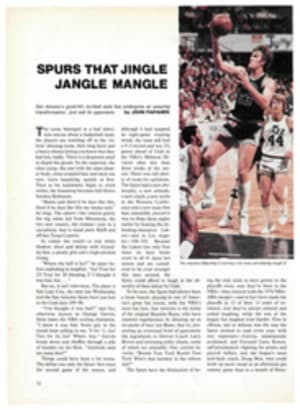
ALTHOUGH GRAND IN SCOPE, THIS NEW BIO OF BOBBY JONES IS, ALAS, SUBPAR
Dick Miller's Triumphant Journey (Holt, Rinehart and Winston, $13.95) is described in the dust-jacket copy as "the first full biography of Bobby Jones...." To accept that claim, you have to accept a fairly loose definition of "full biography."
Miller gives us plenty of detail about the rounds of golf Jones played—especially those that won him the Grand Slam in 1930—but he doesn't tell us much about Jones himself. His is an earnest biography, but a limited one.
The same can be said of virtually all sports biographies. In part that's because few athletes are as interesting as private individuals as they are as public performers. But in larger part it's because biographers of athletes more often than not fall into the trap of emphasizing play-by-play accounts while minimizing the more complex, vexing task of delving into their subjects' characters and personalities.
Only two American sports biographies avoid this pitfall. Interestingly, both are, like Triumphant Journey, about figures from the so-called "Golden Age" of sports, the '20s. Robert Creamer's Babe succeeds in bringing to life a larger-than-life rapscallion and fixing him securely in his proper place in American legend. Frank Deford's Big Bill Tilden succeeds because of its sensitive, discreet examination of Tilden's homosexuality, which caused Tilden such guilt and pain throughout his adult years. (This may sound biased, because both authors are on the staff of SI. It is not. The books stand confidently on their own merits.)
Judging from the evidence that Miller too tentatively presents, the life of Bobby Jones contains more than enough material for a biography of comparable stature. Not merely was Jones a great golfer, arguably the greatest the game has known, but he also was a man of uncommon intelligence and gracious-ness. He overcame serious childhood ailments to reach his unique position in the history of sports. He spent the final two decades of his life courageously fighting a rare, debilitating spinal disease.
He was a complicated man about whom Miller has written a lamentably simple book. Miller admires Jones, which certainly is understandable, but he is too protective of him, too reluctant to probe any distance beneath the surface.
The bare facts of Jones' life are familiar. He was born in 1902 into a prosperous, prominent Georgia family. He took up golf as a very young boy—he was too frail for baseball—and by his 15th birthday had a growing national reputation. In eight years, from 1923 through 1930, playing as an amateur, he won 13 national championships. The climax of his career was his sweep, in 1930, of the American and British amateur and open titles, a feat that has never been matched. He retired from competition after winning the Slam, but he remained close to the game. In 1931 he helped found the Augusta National Golf Club and three years later established the Masters there. He died in 1972.
Miller has chosen to make the Grand Slam the focus of his book. The decision is sensible—a serious biography needs to be built around one or more themes or central occurrences—but the execution is unsatisfactory. For one thing, there's simply too much shot-by-shot recapitulation. For another, the flashbacks to tournaments and other events that happened before 1930 are handled awkwardly and sometimes confusingly.
Moreover, Miller never succeeds in conveying what made Jones a great golfer. To point out that he had strong legs, intense determination and fierce pride just isn't enough. The same could be said of countless other golfers. Miller notes that Jones had a bad temper, a tendency to lose his concentration if he got a big lead and a sharp distaste for the idolatrous attentions of his galleries, but he doesn't explore these revelations as deeply as he might.
Miller is equally reticent about Jones' private life. His marriage seems to have been a happy one, yet there are hints that he and his wife had little in common. He ignored his children when they were small but became more attentive as they grew older. He practiced law in Atlanta for years, but we are told almost nothing about what kind of practice it was or whether Jones was, in fact, a good lawyer. Miller describes Jones' illness thoroughly, yet we really get little sense of what life was like for Jones between his retirement from golf in 1930 and his death 42 years later. Clearly, he was one athlete for whom life did not end after his playing days.
Jones, who was educated at Georgia Tech and Harvard, was an admirable prose stylist. The few examples of his writing cited by Miller suggest that a new edition of Jones' articles on golf would be a valuable addition to the literature of the sport. Miller, though he knows good prose when he sees it, cannot always write it himself.
On Miller's behalf, it should be said that Jones may have been too private a person for any biographer to cope with. The trouble with Triumphant Journey is that Miller just hasn't made enough of an effort to pin Jones down. Miller is polite and deferential, which is all well and good, but good manners don't make good biography.

